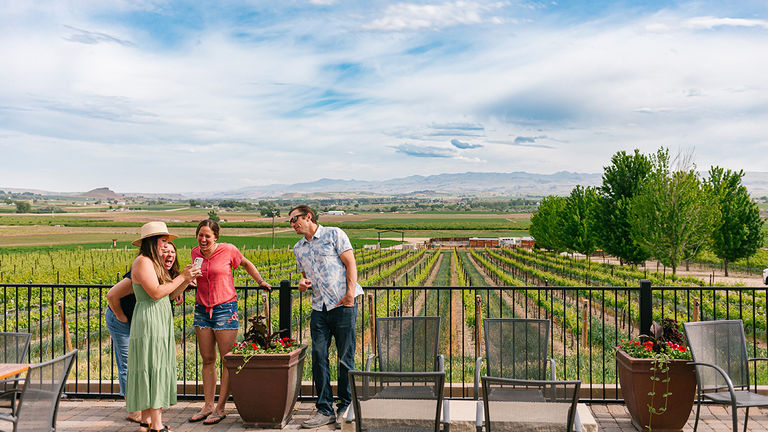When conjuring images of wine country, the mind may wander to California’s Napa Valley region, or Oregon’s Willamette Valley. But wine-lovers looking for a way to taste domestic varietals may be bypassing one of the country’s hidden gems: Idaho.
Settled between the Rocky Mountains and the Snake River, Idaho’s wine county — which grows its grapes with a moderate climate and low rainfall — lends itself to varieties of Syrah, Merlot, Riesling, Chardonnay, Tempranillo and Malbec. The state has 70 wineries and cideries, multiple wine-growing regions and even its own Wine Commission.
“Idaho, in general, is very approachable and laid-back, including our wine scene,” said Moya Dolsby, executive director for the Idaho Wine Commission. “While our wine-growers and makers are incredibly knowledgeable, they meet visitors where they’re at in terms of interests and expertise. Everyone will feel welcome here and walk away with great experiences and memories.
Here, Dolsby shares more about why U.S. travelers should consider a visit.
 Moya Dolsby, executive director for the Idaho Wine Commission
Moya Dolsby, executive director for the Idaho Wine Commission
Credit: 2024 Idaho Wine CommissionWhat should visitors know about the state’s history as a region for wine production?
Idaho’s wine region extends back even further than Prohibition. An Idaho Statesman article dated Sept. 5, 1865, reported that a vineyard of Royal Muscadine cuttings planted the spring prior had survived the winter well and was beginning to produce grapes in Lewiston, Idaho. Our state’s wine industry boomed until 1919 when Prohibition brought things to a halt. Then, Idaho’s first winery opened relatively quickly following the repeal of Prohibition, but it took until 1972 for the second bonded winery to establish. Ever since then, we’ve continued to grow and develop award-winning, world-class wines.
Despite that history, and the fact that it has 70 wineries and cideries, Idaho’s wine country is under-the-radar for travelers. How does the state’s wine country compare to other wine-focused hot spots in the U.S.?
Idaho’s wine-growing regions are pretty parallel to Washington and Oregon’s wine-growing regions, and we’re producing quality wines that match and exceed those in other wine-focused hot spots in the U.S.
The main difference, and a big reason why we’re still a bit under-the-radar for some travelers, is that we only have two wineries in Idaho that distribute nationally, so travelers aren’t likely to see our wines on restaurant and bar menus outside of the state. But for those of us living here, it is no secret that we have incredible wine and talented winemakers. More and more visitors are learning about our wines, too. They may initially decide to visit Idaho for other reasons, like hiking, whitewater rafting or skiing, but then they find out about our wineries and it’s like icing on the cake. They go back home, tell their friends and family and inspire more people to visit.
More and more visitors are learning about our wines, too. They may initially decide to visit Idaho for other reasons, like hiking, whitewater rafting or skiing, but then they find out about our wineries and it’s like icing on the cake.
There are multiple wine-growing regions within the state. How do Idaho’s three regions compare to each other?
Based on climate, geographical conditions and soil content, Idaho’s wine-growing regions are distinctly different. What that means for the consumer is we’re able to grow a much wider diversity of wines with lots of character and nuances.
Starting in the northern part of the state, The Lewis-Clark Valley American Viticultural Area (AVA) is small but growing and known for incredible Cabernet Sauvignon, Cabernet Franc, Merlot, Syrah, Sangiovese, Chardonnay and Riesling. The Snake River Valley AVA is a high desert with big temperature changes from day to night, creating a balance of natural sugars and acids. The region is also rich in volcanic soil and has a near-famous latitude for wine-growing, contributing to a distinct character in the grapes. It’s known for Cabernet Sauvignon, Chardonnay and Syrah, but other varieties do well, too. There are also three cideries in this AVA. A lot of the same elements that make it a great wine-growing region also make it perfect for growing other fruits, including apples. Then, the third AVA is the Eagle Foothills AVA, a sub-appellation of the Snake River Valley. The slope of the foothills plays an important role in this AVA, impacting sunlight reception, cold air drainage, and frost and wind protection. This local climate, along with unique granite soils, contribute to excellent wines.
While there are three formal AVAs, there are really six different regions when it comes to the visitor experience. For example, the Boise and Garden City metro area includes several urban wineries and tasting rooms. Just outside the urban corridor, the Western Treasure Valley is home to the Sunnyslope Wine Trail, a subregion of the Snake River Valley AVA. Here, visitors will find several vineyards and wineries in relatively close proximity with tour operators providing tour packages and transportation between them. And just north of the Lewiston & Moscow Region is the Coeur d’Alene and Sandpoint region, characterized by stunning mountain ranges and lakes.
 Idaho features three formal AVAs but six distinct wine regions when it comes to the visitor experience (pictured here is Coiled Winery).
Idaho features three formal AVAs but six distinct wine regions when it comes to the visitor experience (pictured here is Coiled Winery).
Credit: 2024 Visit BoiseIdaho’s climate, precipitation and elevation all contribute to the flavor profile of its wines. What makes this spot so perfect for growing varieties?
Idaho’s diversity of microclimates and soil conditions make it possible for wine-growers and makers to grow a much wider range of wines, meaning visitors will find several excellent varietals in all of our wine regions. We’re not a state where you’ll find one dominant variety in any given region. Riesling, Chardonnay, Cabernet Sauvignon, Cabernet Franc, Merlot, Syrah, Sangiovese and Tempranillo all excel here. And because we have such diversity of growing conditions, you’ll also find a lot more experimentation and blending, making for truly distinct and unique wines.
Because we have such diversity of growing conditions, you’ll also find a lot more experimentation and blending, making for truly distinct and unique wines.
What’s an ideal itinerary for travelers looking to visit Boise, while also carving out time to visit wine country?
An ideal itinerary would include at least three days for visitors to fully experience the urban wineries and tasting rooms in the Boise and Garden City metro area. The area is home to the renowned Boise River Greenbelt, a 25-mile, tree-lined paved biking and pedestrian pathway that follows the river. There are several tasting rooms, cideries and eateries along the trail, making it a fun and full-day experience.
And the Sunnyslope Wine Trail is just outside the metro area. Several local tour companies provide transportation and packages to explore multiple wineries in this region, making it a fun half day experience.
The Boise area’s culinary and outdoor offerings are incredible, as well, and many visitors that are coming for the wine also want to experience those offerings. Excursions like whitewater rafting, hiking or mountain biking the Boise foothills plus exploring the city’s walkable downtown easily add another day (or two!) to the itinerary.
 Dolsby suggests pairing winery visits with Idaho’s other attractions.
Dolsby suggests pairing winery visits with Idaho’s other attractions.
Credit: 2024 Laney PhotographyAre there certain times of year that are best to visit?
It depends on the experience the visitor wants to have while here. Late spring through fall offer great weather that is perfect for picnicking at the wineries or enjoying a leisurely afternoon on a patio with a glass of local wine. Winter is a special time, too. Part of our programming through the Idaho Wine Commission includes Winter Wine Weekends with different experiences, like wine and food pairings, wine and movie showings and more. And several of the wine-growing regions are within proximity to skiing destinations and more, making it perfect again for those who enjoy both wine and the outdoors.
We have incredible cideries, too, so check out our beverage experiences beyond wine. There is also an abundance of outdoor experiences, and no shortage of multi-day outdoor excursions that are in the same areas as our wine regions. Lastly, Idaho is incredibly family-friendly, including our wineries and cideries, but also our restaurants, cultural attractions and outdoor experiences. While it is perfect for a girls’ or couples’ getaway, it’s also great for those traveling with various age groups.
What resources are available for travel advisors and their clients from the Idaho Wine Commission?
Our team can provide firsthand, knowledgeable experience and help guide travel advisors with itineraries and packages. We can also connect travel advisors with wineries, tour and transportation companies, hotels and our DMO partners, like Visit Boise and Visit Idaho, to provide advisors with additional support and partners.